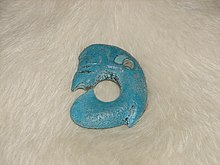Pig dragon

A pig dragon or zhūlóng (simplified Chinese: 玉猪龙; traditional Chinese: 玉豬龍)[1] is a type of jade artifact from the Hongshan culture of neolithic China. Pig dragons are zoomorphic forms with a pig-like head and elongated limbless body coiled around to the head and described as "suggestively fetal".[2] Early pig dragons are thick and stubby, and later examples have more graceful, snakelike bodies.
Pig dragons were produced by the Hongshan culture. Along with the same culture's jade eagles (玉鷹),[1] they often featured as grave goods.[3] Pig bones have been found interred alongside humans at Hongshan burial sites, suggesting that the animal had some ritual significance.
There is some speculation that the pig dragon is the first representation of the Chinese dragon. The character for "dragon" in the earliest Chinese writing has a similar coiled form, as do later jade dragon amulets from the Shang period.[4]
See also[]
- Chinese jade
- Bi (jade)
- Magatama
- Lingling-o
- Gogok
- Cong (jade)
References[]
- ^ a b Ko, Patrick. Federation of Medical Studies of Hong Kong, "The History of Ancient Chinese Jade Culture". Jan 2008.
- ^ Childs-Johnson, Elizabeth (1991). "Jades of the Hongshan culture: the dragon and fertility cult worship". Arts Asiatiques. 46: 82–95. doi:10.3406/arasi.1991.1303.
- ^ Howard, Angela & al. Chinese Sculpture, pp. 21 f. Yale Univ. Press, 2006. ISBN 0-300-10065-5.
- ^ Salviati, Filippo (2002). The Language of Adornment: Chinese Ornaments of Jade, Crystal, Amber and Glass, Fig. 17. Ten Speed Press. ISBN 1-58008-587-3.
External links[]
![]() Media related to Pig dragons at Wikimedia Commons
Media related to Pig dragons at Wikimedia Commons
- Archaeological artifacts of China
- Chinese dragons
- Jade
- Sculpture stubs
- China stubs